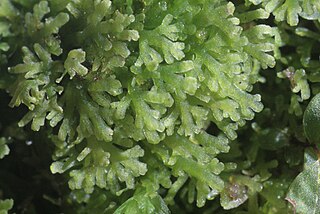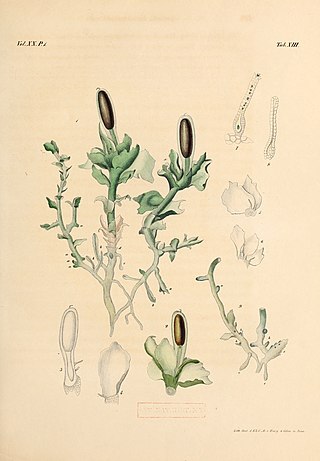
A sporangium ; pl.: sporangia) is an enclosure in which spores are formed. It can be composed of a single cell or can be multicellular. Virtually all plants, fungi, and many other groups form sporangia at some point in their life cycle. Sporangia can produce spores by mitosis, but in land plants and many fungi, sporangia produce genetically distinct haploid spores by meiosis.

Mosses are small, non-vascular flowerless plants in the taxonomic division Bryophytasensu stricto. Bryophyta may also refer to the parent group bryophytes, which comprise liverworts, mosses, and hornworts. Mosses typically form dense green clumps or mats, often in damp or shady locations. The individual plants are usually composed of simple leaves that are generally only one cell thick, attached to a stem that may be branched or unbranched and has only a limited role in conducting water and nutrients. Although some species have conducting tissues, these are generally poorly developed and structurally different from similar tissue found in vascular plants. Mosses do not have seeds and after fertilisation develop sporophytes with unbranched stalks topped with single capsules containing spores. They are typically 0.2–10 cm (0.1–3.9 in) tall, though some species are much larger. Dawsonia, the tallest moss in the world, can grow to 50 cm (20 in) in height. There are approximately 12,000 species.

Bryophytes are a group of land plants (embryophytes), sometimes treated as a taxonomic division, that contains three groups of non-vascular land plants: the liverworts, hornworts, and mosses. In the strict sense, the division Bryophyta consists of the mosses only. Bryophytes are characteristically limited in size and prefer moist habitats although some species can survive in drier environments. The bryophytes consist of about 20,000 plant species. Bryophytes produce enclosed reproductive structures, but they do not produce flowers or seeds. They reproduce sexually by spores and asexually by fragmentation or the production of gemmae.

Thallus, from Latinized Greek θαλλός, meaning "a green shoot" or "twig", is the vegetative tissue of some organisms in diverse groups such as algae, fungi, some liverworts, lichens, and the Myxogastria. A thallus usually names the entire body of a multicellular non-moving organism in which there is no organization of the tissues into organs. Many of these organisms were previously known as the thallophytes, a polyphyletic group of distantly related organisms. An organism or structure resembling a thallus is called thalloid, thallodal, thalliform, thalline, or thallose.

Thallophytes are a polyphyletic group of non-motile organisms traditionally described as "thalloid plants", "relatively simple plants" or "lower plants". They form a division of kingdom Plantae that include lichens and algae and occasionally bryophytes, bacteria and slime moulds. Thallophytes have a hidden reproductive system and hence they are also incorporated into the similar Cryptogamae category, as opposed to Phanerogamae. Thallophytes are defined by having undifferentiated bodies, as opposed to cormophytes (Cormophyta) with roots and stems. Various groups of thallophytes are major contributors to marine ecosystems.

The embryophytes are a clade of plants, also known as Embryophyta or land plants. They are the most familiar group of photoautotrophs that make up the vegetation on Earth's dry lands and wetlands. Embryophytes have a common ancestor with green algae, having emerged within the Phragmoplastophyta clade of freshwater charophyte green algae as a sister taxon of Charophyceae, Coleochaetophyceae and Zygnematophyceae. Embryophytes consist of the bryophytes and the polysporangiophytes. Living embryophytes include hornworts, liverworts, mosses, lycophytes, ferns, gymnosperms and angiosperms. Embryophytes have diplobiontic life cycles.

The Marchantiophyta are a division of non-vascular land plants commonly referred to as hepatics or liverworts. Like mosses and hornworts, they have a gametophyte-dominant life cycle, in which cells of the plant carry only a single set of genetic information. The division name was derived from the genus name Marchantia, named by French botanist Jean Marchant after his father.

Stephan Friedrich Ladislaus Endlicher, also known as Endlicher István László, was an Austrian botanist, numismatist and Sinologist. He was a director of the Botanical Garden of Vienna.

A gemma is a single cell, or a mass of cells, or a modified bud of tissue, that detaches from the parent and develops into a new individual. This type of asexual reproduction is referred to as fragmentation. It is a means of asexual propagation in plants. These structures are commonly found in fungi, algae, liverworts and mosses, but also in some flowering plants such as pygmy sundews and some species of butterworts. Vascular plants have many other methods of asexual reproduction including bulbils and turions.

Metzgeriales is an order of liverworts. The group is sometimes called the simple thalloid liverworts: "thalloid" because the members lack structures resembling stems or leaves, and "simple" because their tissues are thin and relatively undifferentiated. All species in the order have a small gametophyte stage and a smaller, relatively short-lived, spore-bearing stage. Although these plants are almost entirely restricted to regions with high humidity or readily available moisture, the group as a whole is widely distributed, and occurs on every continent except Antarctica.
An oogonium is a small diploid cell which, upon maturation, forms a primordial follicle in a female fetus or the female gametangium of certain thallophytes.

A protonema is a thread-like chain of cells that forms the earliest stage of development of the gametophyte in the life cycle of mosses. When a moss first grows from a spore, it starts as a germ tube, which lengthens and branches into a filamentous complex known as a protonema, which develops into a leafy gametophore, the adult form of a gametophyte in bryophytes.

Succubous is a manner in which the leaves of a liverwort overlap. If one were to look down from above on a plant where the leaf attachment is succubous, the upper edge of each leaf would be covered by the next leaf along the stem. The lower edge of each leaf is visible from above, but the edge of the leaf closer to the tip of the stem is obscured by a neighboring leaf. The opposite of succubous is incubous.

The term incubous describes the way in which the leaves of a liverwort are attached to the stem. If one were to look down from above on a plant where the leaf attachment is incubous, the upper edge of each leaf would overlap the next higher leaf along the stem. Because of this, the upper edge of each leaf is visible from above, but the lower edge of each leaf is obscured by its neighboring leaf. The opposite of incubous is succubous.
Haesselia roraimensis is a species of liverwort in the family Cephaloziaceae. It is endemic to Guyana. Its natural habitat is on rotten logs in periodically flooded riverine forest from 550–1,550 m (1,800–5,090 ft) elevation, in the humid submontane tropical 'mossy' forests on the slopes of Mount Roraima, where the borders of Brazil, Venezuela, and Guyana meet.

Haplomitriopsida is a class of liverworts comprising fifteen species in three genera. Recent cladistic analyses of nuclear, mitochondrial, and plastid gene sequences place this monophyletic group as the basal sister group to all other liverworts. The group thus provides a unique insight into the early evolution of liverworts in particular and of land plants in general.

Polysporangiophytes, also called polysporangiates or formally Polysporangiophyta, are plants in which the spore-bearing generation (sporophyte) has branching stems (axes) that bear sporangia. The name literally means 'many sporangia plant'. The clade includes all land plants (embryophytes) except for the bryophytes whose sporophytes are normally unbranched, even if a few exceptional cases occur. While the definition is independent of the presence of vascular tissue, all living polysporangiophytes also have vascular tissue, i.e., are vascular plants or tracheophytes. Extinct polysporangiophytes are known that have no vascular tissue and so are not tracheophytes.

Rhytidiadelphus squarrosus is a species of moss known as springy turf-moss in the United Kingdom, and square goose neck moss in the United States. It is widespread in Eurasia and North America, and has been introduced to the Southern Hemisphere. It has broad ecological tolerances, and is usually found in man-made habitats such as lawns and golf courses. It is most closely related to R. subpinnatus, with which it is often confused.

Cyathophorum bulbosum, commonly known as quill moss or the false fern moss, is found in the eastern states of Australia as well as Papua New Guinea, New Zealand, Auckland Islands, Chatham Island, Lord Howe Island and possibly Norfolk Island and New Ireland.
Cormus is the appearance of a plant that belong to Cormophyte. In cormus, the vegetative apparatus is no longer a thallus, such as algae, that cannot be distinctly differentiated. The structure of cormus can be easily differentiated into its roots, stems, and leaves.

















